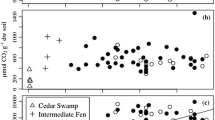Abstract
Drainage, vegetation removal and harvesting, and vegetation restoration have a profound effect on carbon cycling in peatlands. Through laboratory incubations of 114 peat samples collected from the surface layer and just above and just below the water table at 13 sites, we examined the potential for carbon dioxide (CO2) production under aerobic and anaerobic conditions and methane (CH4) production under anaerobic conditions. CO2 production rates ranged from 0.04 to 1.05 mg g−1 d−1 under aerobic conditions and 0.01 to 0.29 mg g−1 d−1 under anaerobic conditions. Rates of CO2 production were generally smallest in the lower parts of the profiles and at the recently restored sites where deep peat was exposed at the surface; they were largest in the freshly-formed surface peat at the undisturbed bog and older restoration sites where a strong cover of vegetation had developed. The CO2 production potentials were negatively correlated with the Von Post Index of decomposition, and aerobic: anaerobic production ratios averaged 4.3: 1. Largest rates of anaerobic CH4 production occurred in samples close to the soil surface with fresh peat accumulation and a high water table, and smallest rates were in samples from the subsurface of sites with a low water table. Anaerobic CH4 production was significantly positively correlated with aerobic and anaerobic CO2 production. These production potentials show that drainage, harvesting, and restoration change the ability of the peat profile to produce and emit CO2 and CH4.
Similar content being viewed by others
Literature cited
AG Boden (ed.). 1994. Bodenkundliche Kartieranleitung, fourth edition, Hannover, Germany.
Bergman, I., P. Lundberg, and M. Nilsson. 1999. Microbial carbon mineralization in an acid surface peat: effects of environmental factors in laboratory incubations. Soil Biology & Biochemistry 31:1867–1877.
Bridgham, S. D. and C. J. Richardson. 1992. Mechanisms controlling soil respiration CO2 and CH4 in southern peatlands. Soil Biology & Biochemistry 24:1089–1099.
Bridgham, S. D., K. Updegraff, and J. Pastor. 1998. Carbon, nitrogen, and phosphorus mineralization in northern wetlands. Ecology 79:1545–1561.
Cleary, J. 2003. Greenhouse gas emissions from peat extraction in Canada: a life cycle perspective. Centre for Climate and Global Change Research, McGill University, Montreal, QC, Canada. Report 2003-1.
Croft, M., L. Rochefort, and C. J. Beauchamp. 2001. Vacuum-extraction of peatlands disturbs bacterial population and microbial biomass carbon. Applied Soil Ecology 18:1–12.
Dooley, M. and C. H. Dickinson. 1970. The microbiology of cutaway peat II. The ecology of fungi in certain habitats. Plant and Soil 32:454–467.
Ferland, C. and L. Rochefort. 1997. Restoration techniques for Sphagnum dominated peatlands. Canadian Journal of Botany 75:1110–1118.
Glatzel, S., K. Kalbitz, M. Dalva, and T. Moore. 2003. Dissolved organic matter properties in natural, harvested, and differently restored peat bogs. Geoderma 113:397–411.
Glenn, S., A. Heyes, and T. R. Moore. 1993. Methane and carbon dioxide fluxes from drained peatland soils. Global Biogeochemical Cycles 7:247–258.
Hogg, E. H., V. L. Lieffers, and R. W. Wein. 1992. Potential carbon losses from peat profiles: Effects of temperature, drought cycles, and fire. Ecological Applications 2:298–306.
Jasinski, S. M. 1999. Peat. Minerals Yearbook 1999: Volume 1-Metals and Minerals. U.S. Geological Survey, Bureau of Mines, Washington, DC, USA.
Moore, T. R. and M. Dalva. 1993. The influence of temperature and water table position on methane and carbon dioxide emissions from laboratory columns of peatland soils. Journal of Soil Science 44:651–664.
Moore, T. R. and M. Dalva. 1997. Methane and carbon dioxide exchange potentials of peat soils in aerobic and anaerobic laboratory incubations. Soil Biology & Biochemistry 29:1157–1164.
Petrone, R. M., J. M. Waddington, and J. S. Price. 2001. Ecosystem scale evapotranspiration and net CO2 exchange from a restored peatland. Hydrological Processes 15:2839–2845.
Robert, E. C., L. Rochefort, and M. Garneau. 1999. Natural revegetation of two block-cut mined peatlands in eastern Canada. Canadian Journal of Botany 77:447–459.
Scanlon, D. and T. R. Moore. 2000. Carbon dioxide production from peatland soil profiles: The influence of temperature, oxic/anoxic conditions and substrate. Soil Science 165:153–160.
Sundh, I., C. Mikkela, M. Nilsson, and B. Svensson. 1995. Potential aerobic methane oxidation in a Sphagnum-dominated peatland—controlling factors and relation to methane emission. Soil Biology & Biochemistry 27:829–837.
Tuittila, E. S., V. M. Komulainen, H. Vasander, and J. Laine. 1999. Restored cut-away peatlands as a sink for atmospheric CO2. Oecologica 120:563–574.
Tuittila, E. S., V. M. Komulainen, H. Vasander, H. Nykänen, P. Martikainen, and J. Laine. 2000. Methane dynamics of a restored cut-away peatland. Global Change Biology 6:569–581.
Updegraff, K., J. Pastor, S. D. Bridgham, and C. A. Johnston. 1995. Environmental and substrate controls over carbon and nitrogen mineralization in northern wetlands. Ecological Applications 5:151–163.
Van den Pol-van Dasselaar, A. and O. Oenema. 1999. Methane production and carbon mineralisation of size and density fractions of peat soils. Soil Biology and Biochemistry 31:877–886.
Waddington, J. M. and K. D. Warner. 2001. Atmospheric CO2 sequestration in restored mined peatlands. Ecoscience 8:359–368.
Waddington, J. M., P. A. Rotenberg, and F. J. Warren. 2001. Peat CO2 production in a natural and cutover peatland: Implications for restoration. Biogeochemistry 54:115–130.
Waddington, J. M., K. D. Warner, and G. W. Kennedy. 2002. Cutover peatlands: a persistent source of atmospheric CO2. Global Biogeochemical Cycles 16:DOI 10.1029/2001GB001398.
Yavitt, J. B., C. J. Williams, and R. K. Wieder. 1997. Production of methane and carbon dioxide in peatland ecosystems across North America: effects of temperature, aeration, and organic chemistry of peat. Geomicrobiology Journal 14:299–316.
Author information
Authors and Affiliations
Rights and permissions
About this article
Cite this article
Glatzel, S., Basiliko, N. & Moore, T. Carbon dioxide and methane production potentials of peats from natural, harvested and restored sites, eastern Québec, Canada. Wetlands 24, 261–267 (2004). https://doi.org/10.1672/0277-5212(2004)024[0261:CDAMPP]2.0.CO;2
Received:
Revised:
Accepted:
Issue Date:
DOI: https://doi.org/10.1672/0277-5212(2004)024[0261:CDAMPP]2.0.CO;2




